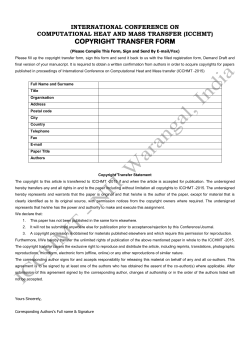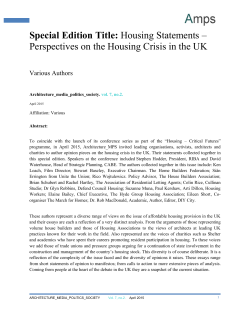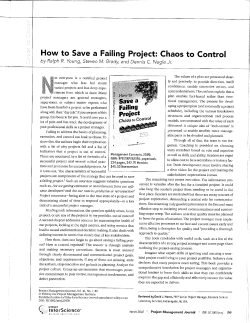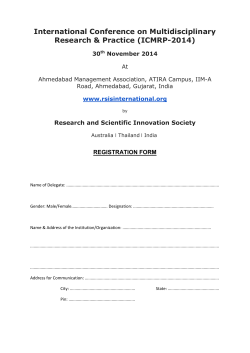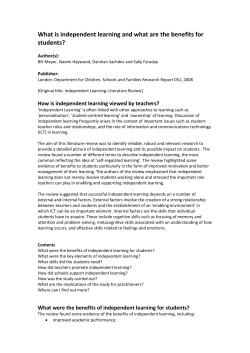
Educational Technology Research Journals
help mitigate or alleviate perceived barriers, and successful integration of classroom technology can D be achieved. References Brickner, D. L., (1995). The effects of first- and second-order barriers to change on the degree and nature of computer usage of mathematics teachers: A case study. Unpublished Educational Technology Research Journals doctoral dissertation, Purdue University, West Lafayette, IN. Clark, K. (2006). Practices for the use of technology in high schools: A Delphi study. fournal of Technology and Teacher Education, 14(3),481-499. Clark, K. E., & Clark, M. B. (1996). Choosing to lead. Greensboro, NC: Center for Creative Leadership. Corn, J. 0., Oliver, K., Hess, C. E., Halstead, E. 0., Argueta, R., Patel, R. K., ... & Huff, J. D. (2010). A computer for every student and teacher: Lessons learned about planning and implementing a successful 1:1 learning initiative in schools. Educational Technology, 50(6); p. 11. Cuban, L. (2006). Commentary: The laptop revolution has no clothes. Education Week, 26(8), p. 29. Ertmer, P A. (1999). Addressing first- and second-order barriers to change: Strategies for technology integration. Educational Technology Research and Development, 47(4), 47-61. Ertmer, P. A. (2005). Teacher pedagogical beliefs: The final frontier in our quest for technology integration? Educational Technology Research and Development, 53(4), 25-39. Ertmer, P. A., Ottenbreit-Leftwich, A. T., Sadik, 0., Sendurur, E., & Sendurur, P. (2012). Teacher beliefs and technology integration practices: A critical relationship. Computers & Education, 59(2), 423-435. Kerr, S. T. (1996). Visions of sugarplums: The future of technology, education, the schools. National Society for the Study of Education, 95, 1-27. Knight, J. (2009). What can we do about teacher resistance? Phi Delta Kappan, 90(7), 508-513. Kopcha, T. J. (2012). Teachers' perceptions of the barriers to technology integration and practices with technology under situated professional development. Computers & Education, 59(4), 1109-1121. Kouzes, J. N., & Posner, B. Z. (2006). The leadership challenge (3rd ed.). Hoboken, NJ: Wiley. Kemp, J. E., & Kalman, H. (2013). Designing effective instruction. Hoboken, NJ: Wiley. Morrison, G. R., Ross, S. M" Northouse, P. G. (2012). Leadership: Theory and practice. Thousand Oaks, CA: Sage Publications. Tunca, B. (2002). Barriers in using technology. Proceedings of World Conference on Educational Multimedia, Hypermedia, and Telecommunications, 2002, 19801982. EDUCATIONAL TECHNOLOGY/March-April2015 Journal of Educational Computing Research, 2003-2012 Rob Nyland Noelle Anderson Tyler Beckstrom Michael Boren Rebecca Thomas Richard E. West Brigham Young University This article analyzes articles published in the Journal· of Educational Computing Research (JECR) from 2003 to 2012. The authors analyzed the articles looking for trends in article types and methodologies, the most common topics addressed in the articles, the top-cited articles, and the top authors during the period. The analysis suggests that JECR employs a primarily inferential approach to their articles, which aligns with the journal's goal of "outcome effects" based research (Journal of Educational Computing Research, n.d.). The most common topics addressed by the articles were "educational technology" and "computer assisted instruction." Introduction The Journal of Educational Computing Research, with it's first issue in 1985, is published by Baywood Publishing Company. For the journal's first nine years, publication was annually four issues and roughly 20 articles per volume. Starting in 1994, the journal doubled its output and frequency. The Journal of Educational Computing Research is a peer-reviewed journal that publishes articles meant for educators, researchers, policymakers, and scientists. Most articles published in the journal focus on "outcome effects" of educational computing applications, design and development of educational hardware and software, research in educational computing fields, 43 and foundations of computer-based education (Journal of Educational Computing Research, n.d.). Since computerbased education is an interest to people from diverse backgrounds, the journal's editors and authors are international and interdisciplinary. The purpose of this study was to analyze articles in the Journal of Educational Computing Research in the years 2003 to 2012. Our purpose in analyzing these articles was to find what kinds of articles (methodologies and topics) are published in this journal as well as to identify the major authors and the most-cited articles of the journal. Methods We reviewed 428 articles published in the Journal of Educational Computing Research between 2003 and 2012. Introductions to issues, editorials, and book reviews were not included in the analysis. We analyzed the articles for trends in article types, topics, authorship, and citations. Article Types and Methodologies The research methodology used in the articles were coded into one of the following categories: o Inferential analysis-Articles using quasi-experimental, experimental, or correlational methods of statistical research. These articles report inferential statistics that test hypotheses or report differences between groups. Additionally, statistics used to validate measurement tools, such as factor analysis, were placed in this category. • Interpretive analysis-Articles that use case studies, interviews, observational studies, or other qualitative methods to gather data and interpretative approaches to analyzing the data. o Descriptive analysis-Articles reporting descriptive statistics, often based on surveys or questionnaires. • Theoretical!conceptual articles - Non - data - based articles and reviews of literature, which are meant to present and discuss theories, models, and technologies. • Combined methods-Articles that combined Interpretive and Inferential/Descriptive methods to interpret and present findings. o Content/discourse analysis-Articles with a purpose of coding written and recorded discourse into discrete, measurable categories, with the data reported descriptively. To ensure reliability between the coders, while analyzing methodologies, the authors used the following system: First, we discussed 10% of the articles together as a group to establish consensus on the methodology definitions, after which we coded the remaining articles. At least 10% of articles were double-coded by another author for spot-check agreement. Any disagreements regarding methodologies were brought before a third person or the group and discussed until consensus was reached. Topic Analysis The authors extracted subject terms for every article from the Educational Resources Information. Center EBSCO database into a spreadsheet and then alphabetized and analyzed them for number of occurrences. In 44 Table 1. Total by methodology from 2003-2012. Method Inferential # of Articles % of Articles (rounded) 261 61% Interpretive 65 15% Combined Methods 3? 9% Descriptive 18 4% Theoretical 33 8% Content Analysis 13 3% Other <1% addition to the subject term analysis, a word frequency count was performed on the article titles, using the Website textalyser.net. Of the 428 articles from the years 20032012, three did not have subject terms provided by EBSCO. Related subject terms and words (such as Education and Education-Research) were combined. Subject terms and words deemed irrelevant to the journal subject matter (such as United States) were not included in the analysis. Citation Analysis We used Google Scholar to determine the number of citations of all published articles from the Journal of Educational Computing Research from 2003-2012. We felt that Google Scholar provides the most comprehensive list available on scholarship, as it is the basis for other scholarship analysis tools, including Publish or Perish (http://www.harzing.com/pop.htm). While Google Scholar, like all scholarship databases, might not be the most statistically valid way of measuring scholarship alone, we nonetheless felt that such an analysiS will still uncover major contributions published in the journal during the highlighted time period. Author Analysis A medal count was used to identify the most prevalent authors. First authors received three points, second authors received two pOints, and additional authors received one point. All author names were organized into an Excel document, and color-coded by authorship (for example, first authors were red and second authors were green). Authors were then placed in alphabetical order, and total pOints for each author were calculated. Authors with the highest number of pOints were identified as the most prevalent authors for the 10 years reviewed in the Journal of Educational Computing Research. Findings Article Types and Methodologies Our analysiS showed that inferential studies are the most common methodology utilized in the Journal of EDUCATIONAL TECHNOLOGY/March-April 2015 Table 2. Article types and methodologies by year. Year Inferential Interpretative Combined Descriptive Theoretical Content Analysis Other Total 2012 33 (77%) 3 (7%) 1 (2%) 3 (7%) 2 (5%) 0 1 (2%) 43 2011 26 (56%) 8 (17%) 9 (20%) 0 3 (7%) 0 0 46 2010 27 (61%) 4 (9%) 6 (14%) 2 (5%) 4 (9%) 1 (2%) 0 44 2009 23 (55%) 7 (17%) 5 (12%) 2 (5%) 1 (2%) 4 (9%) 0 42 2008 28 (70%) 4 (10%) 2 (5%) 2 (5%) 2 (5%) 2 (5%) 0 40 2007 25 (58%) 11 (25%) 2 (5%) 0 3 (7%) 2 (5%) 0 43 2006 29 (71 %) 4 (10%) 0 1 (2%) 5 (12%) 2 (5%) 0 41 2005 18 (44%) 13 (32%) 2 (5%) 2 (5%) 5 (12%) 1 (2%) 0 41 2004 16 (42%) 6 (16%) 10(26%) 2 (5%) 3 (8%) 1 (3%) 0 38 2003 36 (72%) 5 (10%) 0 4(8%) 5 (10%) 0 0 50 Educational Computing Research. As shown in Table 1. inferential articles made up more than half of the articles found in our range from 2003 to 2012, with 261 articies, or about 61 percent. Interpretive analysis ranked second, with 65 articles at 15 percent. Combined methods and theoretical were fairly close for third. The remainder made up little of the content in the journal. In looking at Table 2, it appears that the methodologies of the articles remained fairly consistent throughout the 10-year span of our study, with inferential articles taking the lead every year. There has been a decrease in theoretical articles from the first four years of the analysis period. Occasionally there were other methodologies that would be more prominent behind inferential from year to year, such as in 2004, when combined methods jumped to almost 26 percent. Topic Analysis The topical analysis of the last decade revealed the EBSCO subject terms aligned with the title of the journal, Journal of Educational Computing Research. The cumulative frequencies of the top 20 subject terms for the past decade in the journal are shown in Table 3. The top 20-ranked subject terms made up 28% of the total. The subject terms show an emphasis in computer-based and online educational research for the journal, with computer assisted instruction, Internet in education, computers in education, and Web-based instruction making up 33% of the total occurrences of the top 20 ranked subject terms. The emphaSIS in online and computer-based learning could also be seen in the top 10-ranked words that appeared in the titles of the articles as shown in Table 4. In addition, the journal has had a strong emphasis on articles based on understanding how to make technology integration in education more effective, through an emphasis on learning strategies (3rd-highest subject terrn), the whole educational system surrounding teachingllearning (8th- and 20th-highest subject terms), student perspectives (9th- and 15th-highest term), and teaching strategies EDUCATIONAL TECHNOLOGY/March-ApriI2015 (17th-highest term). Similarly, there was a strong emphasis on learning, students, and cognition issues in the titles of the articles published during this decade. Citation Analysis The two most cited articles in the Journal of Educational Computing Research during the past 10 years were both in 2005. The top five cited papers from 2003-2012 are displayed in Table 5. The article, "What happens when teachers deSign educational technology? The development of Technological Pedagogical Content Knowledge," by Matthew J. Koehler and Punya Mishra, was published in 2005 and has been cited 319 times, the most in this journal for this decade. The second most cited article was "Cyber-harassment: A study of a new method for an old behavior," by Tanya Beran and Qing Li. It was published in 2005, and has been cited 280 times. Roger Azevedo, John T. Guthrie, and Diane Seibert also wrote a key article in 2004, "The role of self-regulated learning in fostering students' conceptual understanding of complex systems with hypermedia," that has been cited 195 times. Nearly all of the top five cited papers used inferential methodologies. Since article citations tend to favor older articles that have more time to be referenced in other studies, the authors also examined the top-cited paper for each year of analysis (see Table 6). It is interesting to note that three of the top-cited papers for each year address the TPACK framework. Author Analysis From 2003 to 2012, the Journal of Educational Computing Research published 428 research articles authored by 923 different people. The most prevalent authors as determined by medal count publication points are shown in Table 7. Roy Clariana, who received 14 publication points in five papers, was determined to be the most prevalent author. Karen Swan, who received 13 publication points in six papers, was a close second, fol- 45 Table 3. EBSCO subject term occurrences for Table 4. Word occurrences in article titles for 2003-2013. 2003-2012. Rank Subjects Educational Technology Occurrences Rank 110 Word Occurrences learning 137 2 Computer Assisted Instruction 90 2 students 96 3 Learning 71 3 computer 70 4 Internet in Education 68 4 online 62 5 Computers in Education 62. 5 technology 57 6 Education-Research 59 6 effects 46 7 Web-based Instruction 54 7 cognitive 29 8 Instructional Systems 44 7 Web 29 9 Students 37 9 knowledge 27 10 Educational Innovations 29 10 teachers 26 11 Teaching Aids and Devices 26 12 Teaching Methods 25 12 Academic Achievement 25 14 Distance Education 24 15 College Students 22 16 Problem Solving 20 17 Teaching 16 17 Teachers 16 "technology" show that the subject of articles in the journal typically stay within its aims. The top citations of the journal from 2003-2012 further show the emphasis on inferential approaches to research in educational technology. Nearly all of the top-cited papers for the period use inferential methodologies. The top-cited paper (Koehler & Misra, 2005) uses the TPACK framework for educational technology integration in the classroom. 0 19 Technology 15 References 20 Instructional Systems Design 14 lowed by Xun Ge, Albert Ritzhaupt, David Passig, and Roger Azevedo. All authors listed in the table published at least four papers and received at least 10 publication points in the years 2003-2012 olthe Journal of Educational Computing Research. Discussion In reflecting on the overall findings of our analysis, we found that the Journal of Educational Computing Research primarily used inferential-based articles during this decade in achieving its research goals. This methodology seems to align with the journal's goal of investigating "outcome effects" of educational computing applications (Journal of Educational ... , n.d.). By using methodologies that utilize an experimental or quasi-experimental approach, it seems that article authors are trying to establish an empirical basis for the efficacy of their deSigns. Such a goal may also be reflected in the second-highest used methodology, interpretive, with some authors taking a qualitative approach to establish effects of computer-based education. The journal's focus on educational computing is also reaffirmed in the keyword analysis. Top EBSCO phrases such as "Computer Assisted Instruction" and "Computers in Education," as well as abstract keywords "computer" and 46 Azevedo, R., Guthrie, J. T., & Seibert, D. (2004). The role of self-regulated learning in fostering students' conceptual understanding of complex systems with hypermedia. Journal of Educational Computing Research, 30(1), 87-111. Hewitt, J. (2003). How habitual online practices affect the development of asynchronous discussion threads. Journal of Educational Computing Research, 28(1), 31-45. Beran, T., & Li, Q. (2005). Cyber-harassment: A study of a new method for an old behavior. Journal of Educational Computing Research, 32(3), 265-277. Doering, A., Veletsianos, G., Scharber, C., & Miller, C. (2009). Using the Technological, Pedagogical, and Content Knowledge framework to design online learning environments and professional development. Journal of Educational Computing Research, 41(3), 319-346. Greene, J. A., & Azevedo, R. (2007). Adolescents' use of self-regulatory processes and their relation to qualitative mental model shifts while using hypermedia. Journal of Educational Computing Research, 36(2), 125-148. Grimes, D., & Warschauer, M. (2008). Learning with laptops: A multi-method case study. Journal of Educational Computing Research, 38(3), 305-332. Hewitt, J. (2003). How habitual online practices affect the development of asynchronous discussion threads. Journal of Educational Computing Research, 28(1), 31-45. EDUCATIONAL TECHNOLOGY/March-April2015 Table 5. Top-cited articles ?verall for Year Title 2003-2012. Citations Author(s) Method 2005 What happens when teachers design educational technology? The development of Technological Pedagogical Content Knowledge 319 Matthew J. Koehler and Punya Mishra Inferential 2005 Cyber-harassment: A study of a new method for an old behavior 280 Tanya Beran and Qing Li Inferential 2004 The role of self-regulated learning in fostering students' conceptual understanding of complex systems with hypermedia 209 Roger Azevedo, John T. Guthrie, and Diane Seibert Combined 2006 Computer gaming and interactive simulations for learning: A meta-analysis 195 Jennifer J. Vogel, David S. Vogel, Jan CannonBowers, Clint A. Bowers, Kathryn Muse, and Michael Wright Inferential 2003 How habitual online practices affect the development of asynchronous discussion threads 152 Jim Hewitt Inferential Table 6 •. Most cited articles for each year, Year Title Citations 2003-2012. Author Methods 2003 How habitual online practices affect the development of asynchronous discussion threads 152 Jim Hewitt Inferential 2004 The role of self-regulated learning in fostering students' conceptual understanding of complex systems with hypermedia 209 Roger Azevedo, John T. Guthrie, and Diane Seibert Combined 2005 What happens when teachers design educational technology? The development of Technological Pedagogical Content Knowledge 319 Matthew J. Koehler and Punya Mishra Inferential 2006 Computer gaming and interactive simulations for learning: A meta-analysis 195 Jennifer J. Vogel, David S. Vogel, Jan CannonBowers, Clint A. Bowers, Kathryn Muse, and Michael Wright Inferential 2007 Adolescents' use of self-regulatory processes and their relation to qualitative mental model shifts while using hypermedia 71 Jeffrey Alan Greene and Roger Azevedo Interpretive 2008 Learning with laptops: A multi-method case study 56 Douglas Grimes and Mark Warschauer Combined 2009 Using the Technological, Pedagogical, and Content Knowledge framework to deSign online learning environments and professional development 48 Aaron Doering, George Veletsianos, Cassandra Scharber, and Charles Miller Combined 2010 Adding instructional features that promote learning in a game-like environment 36 Richard E. Mayer and Cheryl I. Johnson Inferential 2011 Developing pre-service teachers' technology integration expertise through the TPACK-developing instructional model 23 Joyce H.L. Koh and Shanti Divaharan Interpretive 2012 Do one-to-one initiatives bridge the way to 21 st century knowledge and skills? 4 Deborah L. Lowther, Fethi A. Inan, Steven M. Ross, and J. Daniel Strahl Inferential EDUCATIONAL TECHNOLOGY/March-ApriI2015 47 Table 7. Journal authorship by medal count publication points and total papers. Publication Points Total Papers Roy Clariana 14 5 Karen Swan 13 6 Xun Ge 12 5 Albert Ritzhaupt 12 5 David Passig 11 4 Roger Azevedo 10 4 Author Names Journal of Educational Computing Research. (n.d.); http:// jrnledcompresearch.com/index.php/jecr/index . Koeh[er, M. J., & Mishra, P. (2005). What happens when teachers design educational technology? The development of Technological Pedagogical Content Knowledge. Journal of Educational Computing Research, 32(2), 131-152. Koh, J. H., & Divaharan, S. (2011). Developing pre-service teachers' technology integration ex'pertise through the TPACK-developing instructional model. Journal of Educational Computing Research, 44(1), 35-58. Lowther, D. L., [nan, F. A., Ross, S. M., & Strahl, J. D. (2012). Do one-to-one [initiatives bridge the way to 21st century knowledge and skills? Journal of Educational Computing Research, 46(1), 1-30. Mayer, R. E., & Johnson, C. I. (2010). Adding instructional features that promote learning in a game-like environment. Journal of Educational Computing Research, 42(3), 241-265. Vogel, J. J., Vogel, D. S., Cannon-Bowers, J., Bowers, C. A., Muse, K., & Wright, M. (2006). Computer gaming and interactive simulations for learning: A metaanalysis. Journal of Educational Computing Research, 34(3), 229-243. Rob Nyland is a graduate student in Instructional Psychology and Technology studying open education (email: robnyland@gmail.com). Noelle Anderson is a graduate student in Civil Engineering. Tyler Beckstrom is a graduate student in Instructional Psychology and Technology pursuing research in online and blended learning as well as how sequential art can be used as a way of presenting educational material; his portfoliO is available online at: http://tylerbbeckstrom.weebly.com . Michael Boren is a graduate student in Instructional Psychology and Technology studying how documentary films can change perception on culture. Rebecca Thomas is a graduate student in Instructional Psychology and Technology focusing on online and blended learning, project-based learning, and alternative dissertation formats. Richard E. West, a Contributing Editor and Editor of this series, is an Assistant Professor researching collaborative innovation and online collaborative learning. His research, presentations, and other scholarly contributions are available at: http://richardewest.com . All authors are associated with Brigham Young University. 48 Q & A with Ed Tech Leaders Interview with Punya Mishra Susan M. Fulgham Michael ~Shaughnessy Contributing Editors 1. What are you currently working on? Most of my current work has focused on creativity, specifically teacher creativity and how teachers can sustain creativity in their students. Within that, of course, is the ro[e Punya Mishra is Professor of Educational Psychology and Educational Technology at Michigan State University, where he directs the Master of Arts in Educational Technology program. He currently chairs the Creativity Special Interest Group at the Society for Information Technology in Teacher Education. He is former chair of the Innovation & Technology Committee of the American Association of Colleges of Teacher Education (AACTE). He is nationally and internationally recognized for his work on the theoretical, cognitive, and social aspects related to the design and use of computer-based learning environments. He has worked extensively in the area of technology integration in teacher education, which led to the development (in collaboration with M. J. Koehler) of the Technological Pedagogical Content Knowledge (TPACK) framework, which has been described as being 'the most significant advancement in the area of technology integration in the past 25 years." His current research focuses on teacher creativity and the role that technology can play in the process. He has authored over 50 articles and book chapters and has edited two books. Dr. Mishra is an award-winning instructor who teaches courses at both the master's and doctoral levels in the areas of educational technology, design, and creativity. He is also an accomplished visual artist and poet (e-mail: punya@msu.edu). Susan M. Fulgham is Senior Instructional Designer and adjunct instructor for the College of Education at West Texas A & M University, Canyon, Texas (e-mail: sfulgham@bfulgham. com). Michael F. Shaughnessy is Professor of Special Education and Director of the New Mexico Educational Software Clearinghouse at Eastern New Mexico University in Portales, New Mexico (e-mail: Michael.Shaughnessy@enmu.edu). EDUCATIONAL TECHNOLOGY/March-April 2015
© Copyright 2025

